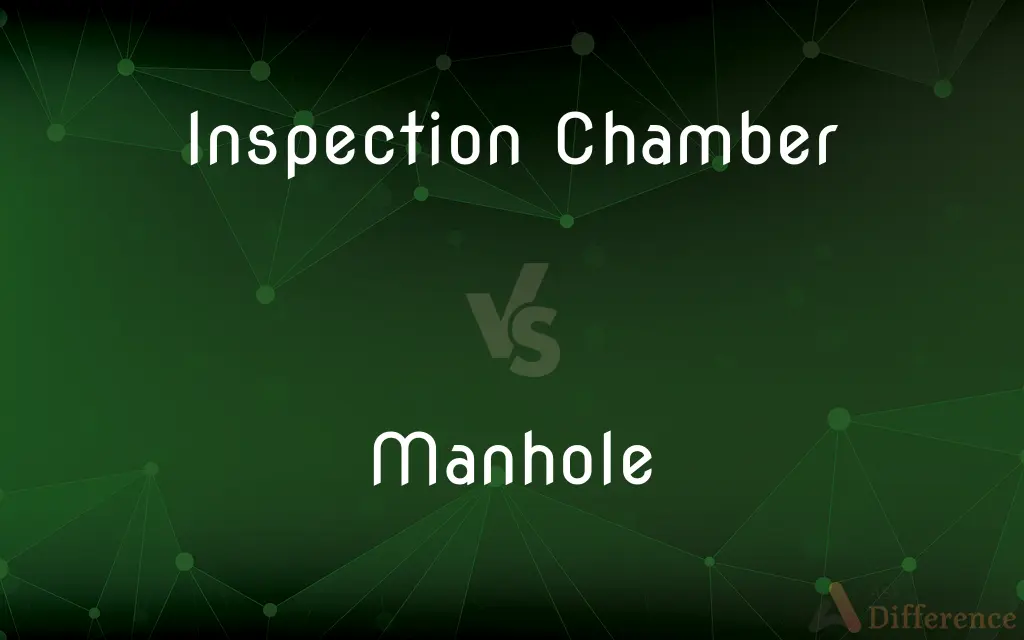Inspection Chamber vs. Manhole — What's the Difference?
By Fiza Rafique & Maham Liaqat — Published on March 1, 2024
An inspection chamber is a point of access to sewers or drainage systems for inspection and maintenance, while a manhole is a larger access point allowing a person to enter underground utilities for inspection, maintenance, or repair.

Difference Between Inspection Chamber and Manhole
Table of Contents
ADVERTISEMENT
Key Differences
Inspection chambers and manholes serve similar purposes in providing access to underground utilities, but they differ in size, accessibility, and function. Inspection chambers are typically smaller and used for accessing drains at junctions or changes in direction, allowing for inspection and blockage clearance without entry. Manholes, on the other hand, are designed to be large enough for a person to enter, facilitating more extensive maintenance and repair tasks.
The design of inspection chambers usually includes a removable cover and may have steps or ladders, but due to their smaller size, they do not allow for human entry. They are intended for quick checks and minor maintenance tasks. Manholes, with their larger size, are equipped with safety features to protect workers entering potentially hazardous environments. They are found in both sewer and stormwater systems as well as other utility networks, like electrical and telecommunications conduits.
Inspection chambers are often found in residential or light commercial drainage systems where direct human access is not necessary for the majority of maintenance tasks. Manholes are more common in municipal and industrial settings, where the complexity and scale of the underground utilities require direct human intervention for inspection, maintenance, and repair.
Regulations and building codes frequently dictate when and where each should be used, with specific requirements based on the depth and type of the utility service. Inspection chambers are preferred for shallower depths where tools can easily reach, while manholes are mandated at greater depths or in more complex systems to ensure safety and accessibility.
The choice between an inspection chamber and a manhole is determined by the expected maintenance needs, the depth of the installation, and regulatory requirements. While inspection chambers are cost-effective for simple access and minor interventions, manholes provide the necessary access for comprehensive maintenance and emergency repairs in deeper and more complex systems.
ADVERTISEMENT
Comparison Chart
Size
Smaller, limited access
Larger, allows human entry
Purpose
Inspection, minor maintenance
Inspection, maintenance, repair
Accessibility
No human entry, tools only
Designed for human entry
Installation Location
Residential, light commercial
Municipal, industrial, complex networks
Safety Features
Limited, due to no entry
Equipped with steps, ladders, and sometimes ventilation
Regulatory Requirements
Used for shallower systems, specific codes dictate use
Required for deeper or more complex systems
Maintenance Scope
Suitable for quick checks and clearing blockages
Allows for extensive repairs and maintenance
Utility Types
Primarily drainage and sewer systems
Sewer, stormwater, electrical, telecommunications
Compare with Definitions
Inspection Chamber
Features a removable cover for access.
The inspection chamber cover was removed for a routine inspection.
Manhole
An access point allowing personnel to enter underground utilities.
The maintenance crew accessed the sewer system through the manhole for repairs.
Inspection Chamber
A point of access for sewer or drainage system inspection and minor maintenance.
An inspection chamber was installed at every junction of the residential drainage system.
Manhole
Large enough for a person to pass through.
Manholes in the city's main streets are equipped with safety ladders.
Inspection Chamber
Typically smaller and does not allow for human entry.
The plumber used a camera probe through the inspection chamber to locate the blockage.
Manhole
Used for maintenance and repair of utilities.
A new manhole was installed to provide access to the underground electrical cables.
Inspection Chamber
Often found in less complex drainage systems.
New building codes required additional inspection chambers for the expanded drainage network.
Manhole
Features safety measures for entry.
The manhole was ventilated before entry to ensure it was safe from toxic gases.
Inspection Chamber
Designed for quick checks and blockage clearance.
Regular checks through the inspection chamber help prevent major sewer backups.
Manhole
Can be found in various utility networks.
Telecommunication lines were inspected via the manhole near the intersection.
Manhole
A hole, usually with a cover, through which a person may enter a sewer, boiler, drain, or similar structure.
Manhole
A hole in the ground used to access the sewers or other underground vaults and installations.
Manhole
A hole providing access to the inside of a boiler, tank etc.
Manhole
A hole through which a man may descend or creep into a drain, sewer, steam boiler, parts of machinery, etc., for cleaning or repairing.
Manhole
A hole (usually with a flush cover) through which a person can gain access to an underground structure
Common Curiosities
Can the type of utility determine whether an inspection chamber or manhole is used?
Yes, deeper and more complex utility systems, like municipal sewers or telecommunications, typically require manholes for adequate access and safety.
Can inspection chambers be used for any repairs?
Inspection chambers are used for minor repairs and maintenance that do not require direct human access, such as clearing blockages with tools.
How do safety requirements differ for inspection chambers and manholes?
Safety requirements for manholes are more stringent, including provisions for entry, ventilation, and rescue, due to the potential for human entry.
How do environmental regulations impact the use of inspection chambers and manholes?
Environmental regulations may dictate the design and placement of both to prevent contamination and ensure safe access to underground utilities.
Is there a cost difference between installing an inspection chamber and a manhole?
Yes, manholes are generally more expensive to install due to their larger size, safety features, and the need for human access.
What is the main difference between an inspection chamber and a manhole?
The main difference is size and accessibility; inspection chambers are smaller and not for human entry, while manholes are larger and allow for personnel to enter.
Why are manholes necessary in urban areas?
Manholes provide critical access for the maintenance, inspection, and repair of underground utilities, essential in complex urban infrastructure.
Are there different types of covers for inspection chambers and manholes?
Yes, covers vary based on load-bearing requirements, with manhole covers designed to withstand heavier loads, including vehicular traffic.
How does maintenance frequency influence the choice between an inspection chamber and a manhole?
Systems requiring frequent or extensive maintenance are more likely to use manholes for easier access, while inspection chambers are suitable for systems with less maintenance needs.
Can both inspection chambers and manholes be found in a single utility system?
Yes, a comprehensive utility system may use both, with inspection chambers for simpler access points and manholes for main access and complex maintenance areas.
Share Your Discovery

Previous Comparison
Mulch vs. Wood Chips
Next Comparison
Pledged vs. DonatedAuthor Spotlight
Written by
Fiza RafiqueFiza Rafique is a skilled content writer at AskDifference.com, where she meticulously refines and enhances written pieces. Drawing from her vast editorial expertise, Fiza ensures clarity, accuracy, and precision in every article. Passionate about language, she continually seeks to elevate the quality of content for readers worldwide.
Co-written by
Maham Liaqat













































